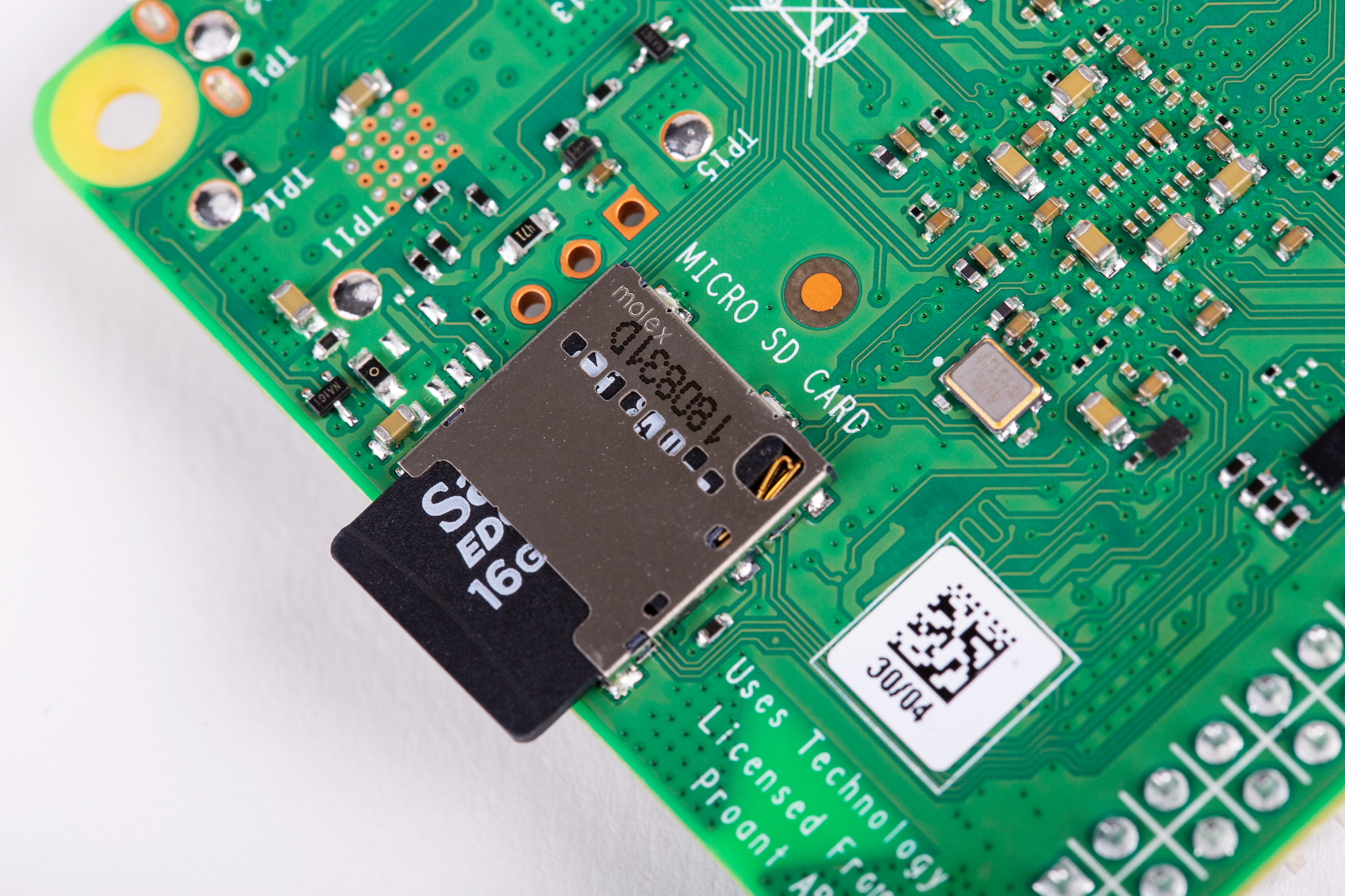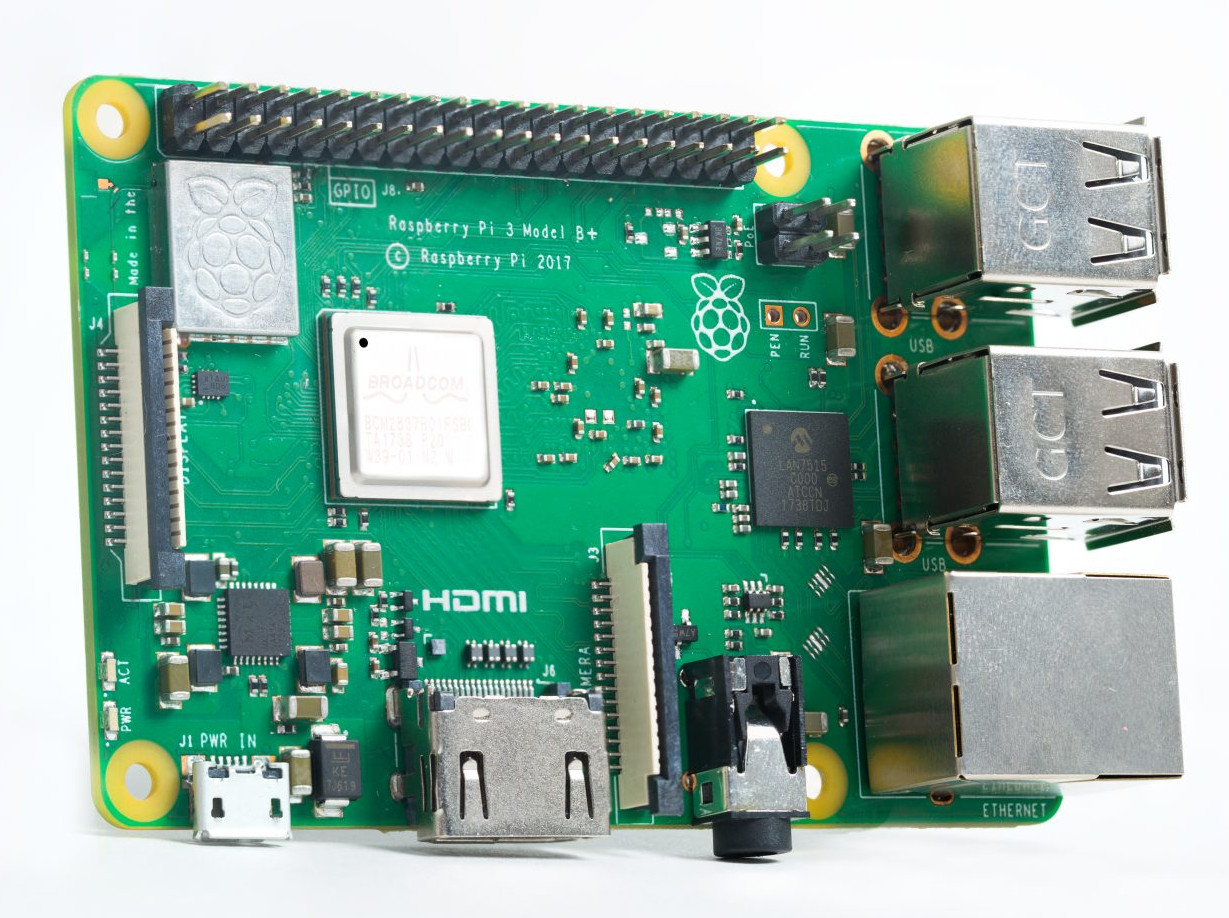Raspberry Pi 3 B+ Micro Sd Slot
From the Model B+ (2014) onwards, a micro SD card is required. We recommend buying the Raspberry Pi SD card which is available here, as well as from other retailers; this is an 8GB class 6 micro SD card (with a full-size SD adapter) that outperforms almost all other SD cards on the market and is a good value solution. Built on the latest Broadcom 2837 ARMv8 64bit processor the new generation Raspberry Pi 3 Model B is faster and more powerful than its predecessors. It has improved power management to support more powerful external USB devices and further to customer feedback based development the new Raspberry Pi 3 now comes with built-in wireless.
Raspberry Pi newcomers ask us to explain the difference between Raspberry Pi 4 and the older Raspberry Pi 3B+ models.
Obviously, Raspberry Pi 4 is one better, but you can pick up a Raspberry Pi 3 for less money (and it's more frequently found on sale). So should you buy the new Raspberry Pi 4, or pick up an older Raspberry Pi 3?
The first thing to note is that there's currently only one Raspberry Pi 4 model, but there are quite a few different Raspberry Pi 3 models. Here are some of the options:
Raspberry Pi 4 Model B: The fourth-generation Raspberry Pi computer
Raspberry Pi 3 Model B+: The final revision of the third-generation Raspberry Pi
Raspberry Pi 3 Model B: The third-generation Raspberry Pi
For the purposes of this article, we're looking at Raspberry Pi 4 vs Raspberry Pi 3B+ (its closest predecessor). But there are many more Raspberry Pi boards available, including the smaller Pi Zero W and energy efficient Raspberry Pi 3 Model A+. As well as older Raspberry Pi 2 Model B and the Raspberry Pi 1 Model B.
Raspberry Pi 4 vs Raspberry PI 3B+: CPU, RAM, and graphics
Raspberry Pi 4 is a clear winner when it comes to pure specifications and hardware grunt.

Raspberry Pi 4 sports a faster 1.5GHz clock speed processor (up from the 1.4GHz found on Raspberry Pi 3B+).
Raspberry Pi 3 is no slouch, though: it also features a quad-core processor and the clock-speed of 1.4GHz is in the same ballpark.
When it comes to RAM, though, Raspberry Pi 4 is streets ahead. As well as the entry-level 1GB configuration, you can get a 2GB model or 4GB model. When it comes to electronics and engineering projects, 1GB is often enough.
Raspberry Pi 3 vs Raspberry Pi 4 performance
For desktop computing, the 4GB Raspberry Pi 4 is a whole different animal to the Raspberry Pi 3B+ (see: Raspberry Pi 4 your next desktop PC in The MagPi magazine issue 85).
Our extensive Raspberry Pi 4 benchmark tests show a tremendous increase in performance on the new Raspberry Pi 4 over Raspberry Pi 3B+ (and all earlier models):
Raspberry Pi 4: CPU and RAM
Broadcom BCM2711, Quad-core Cortex-A72 (ARM v8) 64-bit SoC @ 1.5GHz
1GB, 2GB, or 4GB LPDDR4-3200 SDRAM (depending on model)
Raspberry Pi 3B+: CPU and RAM
Broadcom BCM2837B0, Quad-core Cortex-A53 (ARMv8) 64-bit SoC @ 1.4GHz
1GB LPDDR2 SDRAM
Connectivity and ports
Both models of Raspberry Pi offer a range of connectivity options, including wireless LAN, Bluetooth, Ethernet, USB, and a 40-pin GPIO header (used to hook up electronic components and add specially designed Raspberry Pi HATs (Hardware Attached on Top).
Raspberry Pi 4 has a modern implementation of most of the connections. While wireless LAN is up-to-date on both models, Raspberry Pi 4 has Bluetooth 5.0 with improved speed, range, and capacity; much faster USB 3.0 ports; and unconstrained Gigabit Ethernet (which is constrained by the USB connection on the older Raspberry Pi 3).
Both devices use a microSD card slot for loading the operating system and data storage.
Raspberry Pi 4 connectivity
2.4GHz and 5.0GHz IEEE 802.11ac wireless, Bluetooth 5.0, BLE
Gigabit Ethernet
2 × USB 3.0 ports; 2 × USB 2.0 ports.
Raspberry Pi standard 40-pin GPIO header
2-lane MIPI DSI display port
2-lane MIPI CSI camera port
4-pole stereo audio and composite video port
Raspberry Pi 3B+ connectivity
2.4GHz and 5GHz IEEE 802.11.b/g/n/ac wireless LAN, Bluetooth 4.2, BLE
Gigabit Ethernet over USB 2.0 (maximum throughput 300Mbps)
4 × USB 2.0 ports
Raspberry Pi standard 40-pin GPIO header
2-lane MIPI DSI display port
2-lane MIPI CSI camera port
4-pole stereo audio and composite video port

Display connectivity
When it comes to display connectivity, Raspberry Pi 4 is quite literally twice as good. It sports not one but two HDMI ports, enabling you to run two display monitors. Raspberry Pi 4 is also capable of running 4K video (4096 × 2160 pixels) at 60 frames-per-second, making it ideal for modern media playback.
Raspberry Pi 3B+ has a single full-size HDMI connector, capable of running 1080p (1920×1080p).

One upside to the Raspberry Pi 3B+ is you're more likely to already have full-size HDMI cables around the house, but micro-HDMI to full-size HDMI cables are easy to source.
Raspberry Pi 4 display
2 × micro-HDMI ports (up to 4kp60 supported)
H.265 (4kp60 decode), H.264 (1080p60 decode, 1080p30 encode)
Raspberry Pi 3 display
1 × Full-size HDMI (up to 1080p)
Raspberry Pi 4 vs Raspberry Pi 3B+ power

Raspberry Pi 4 introduced a new USB-C connector for power. However, its power demands are more stringent than Raspberry Pi 3B+ (which uses an older micro-USB connector).
Raspberry Pi 3b+ Micro Sd Slot
Both devices support the separate Power over Ethernet (PoE) HAT if you wish to power the board directly from a power-enabled Ethernet line (handy for remote networking locations).
Raspberry Pi 4 power
5V DC via USB-C connector (minimum 3A*)
5V DC via GPIO header (minimum 3A*)
Power over Ethernet (PoE) enabled (requires separate PoE HAT)
* A good-quality 2.5A power supply can be used if downstream USB peripherals consume less than 500mA in total.
Raspberry Pi 3B+ power
5V/2.5A DC micro-USB connector
Power over Ethernet (PoE) support (requires separate PoE HAT)
Which Raspberry Pi should I buy?
We think both Raspberry 4 and the previous Raspberry Pi 3B+ models are great choices. You can learn about electronics and programming pretty well on both devices, although the faster processor and higher levels of RAM provided on Raspberry Pi 4 make it a much more versatile desktop computer. It also supports more demanding software, such as Scratch 3 (which only runs on the newer Raspberry Pi 4).
It makes for a much more versatile machine, too, with better internet support. And retro game emulation is much improved on the newer Raspberry Pi.
But if what you want is to play around with electronics and code, or build a low-cost media player, then Raspberry Pi 3B+ remains a good option (especially if you can pick one up at a reduced price).
How do I install NOOBS on a Raspberry Pi is a common question for beginner's to ask. NOOBS (New Out Of Box Software) is a piece of software designed to make installing an OS (operating system) on a Raspberry Pi as quick and simple as possible.
With NOOBS you can install Raspbian (the default OS for Raspberry Pi) along with other operating systems that turn the Raspberry Pi into a retro gaming console, media player, and much more.
In this tutorial:
- How to format an microSD Card
- Download and copy the NOOBS software to the microSD Card
- Power up a Raspberry Pi and use NOOBS to install Raspbian OS
- Setting up Raspbian OS
See also:
- Install NOOBS on a Raspberry Pi
Now you’ve got all the pieces together, it’s time to install an operating system on your Raspberry Pi, so you can start using it.
Raspbian is the official OS for the Raspberry Pi, and the easiest way to set up Raspbian on your Raspberry Pi is to use NOOBS (New Out Of Box Software).
If you bought a NOOBS pre-installed 16GB microSD card, you can skip to 'Assemble your Raspberry Pi'. Otherwise you’ll need to format a microSD card and copy the NOOBS software to it.
Prepare to format
Start by downloading SD Card Formatter tool from the SD Card Association website. Now attach the microSD card to your PC or Mac computer and launch SD Card Formatter (click Yes to allow Windows to run it). If the card isn’t automatically recognised, remove and reattach it and click Refresh. The card should be selected automatically (or choose the right one from the list).
Format the microSD
Choose the Quick Format option and then click Format (if using a Mac, you’ll need to enter your admin password at this point). When the card has completed the formatting process, it’s ready for use in your Raspberry Pi. Leave the microSD card in your computer for now and simply note the location of your duly formatted card. Windows will often assign it a hard drive letter, such as D; on a Mac it will appear in the Devices part of a Finder window.
Download NOOBS from Raspberry Pi
Raspberry Pi 3 B+ Micro Sd Slot Card
Download the NOOBS software from the Raspberry Pi website. NOOBS (New Out Of Box System) provides a choice of Raspberry Pi operating systems and installs them for you. Click ‘Download zip’ and save the file to your Downloads folder. When the zip file download is complete, double-click to launch and uncompress the folder. You’ll need to copy all the files from the NOOBS folder to your microSD card. Press CTRL+A (⌘+A on a Mac) to select all the files, then drag all the files to the SD card folder. Once they’ve copied across, eject your SD card. Be careful to copy the files inside the NOOBS folder to the microSD card (not the NOOBS folder itself).
Assemble your Raspberry Pi
Now it’s time to physically set up your Raspberry Pi. Plug your PC monitor into the mains and attach its HDMI cable to the corresponding HDMI port on your Raspberry Pi. Attach the micro USB end to the Raspberry Pi. Use the remaining USB ports to attach keyboard and mouse. Finally, remove the microSD card from the SD card adapter and slot it into the underside of your Raspberry Pi 3B+ or 3. Pi Zero W owners will need to attach a USB hub to connect mouse, keyboard, and monitor. The Zero W’s microSD card slot is on the top of its circuit board.
Power up the Raspberry Pi
Plug in your Raspberry Pi power supply and, after a few seconds, the screen should come on. When the NOOBS installer appears, you’ll see a choice of operating systems. We’re going to install Raspbian Full [RECOMMENDED], the first and most feature-packed OS. Tick this option and click Install, then click Yes to confirm. For more OS options, instead click ‘Wifi networks’ and enter your wireless password; more OS choices will appear. Installation takes its time but will complete – eventually. After this, a message confirming the success installation appears. Your Raspberry Pi will prompt you to click OK, after which it will reboot and load the Raspbian OS.
Start Raspbian OS and get online
When Raspbian loads for the first time, you need to set a few preferences. Click Next, when prompted, then select your time zone and preferred language and create a login password. You’re now ready to get online. Choose your WiFi network and type any required password. Once connected, click Next to allow Raspbian to check for any OS updates. When it’s done so, it may ask to reboot so the updates can be applied.
Click the Raspberry Pi icon at the top left of the screen to access familiar items such as the LibreOffice suite, internet, games, and accessories such as the image viewer, text editor, and calculator. You’re all set to start enjoying your very own Raspberry Pi.